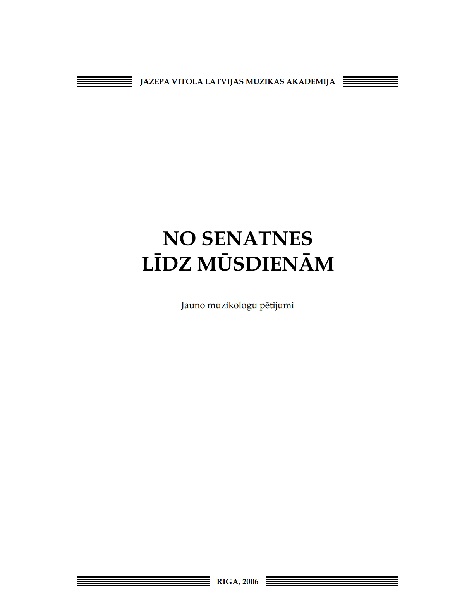ROMANTICISM STILL ALIVE ... A FEW TRENDS IN CONTEMPORARY LATVIAN SYMPHONIC MUSIC
Keywords:
Latvia, symphnoic music, contemporary music, Avant-garde, neoromanticism, The new simplicity, 20th centuryAbstract
The neoromanticism proves to be a characteristic trend in the contemporary Latvian symphonic music. This style is preserving and developing the ideas of new simplicity, new sensuality, new tonality and new romanticism, which emerged in the 70s of the 20th century.
As to the conceptual level modern Latvian symphonic music is dominated by a wide range of powerful contrasts. The system of musical images of the neoromanticism is rich in both a more universal scope means of expression and belief in ethic ideal. Such a line is typical for the symphonies written in the 90s of the 20th century by such composers as Arturs Maskats, Juris Karlsons, Pēteris Vasks and Andris Vecumnieks. This music carries on the tradition of the so-called great symphony, pioneered in the 19th century by such luminaries as L. van Beethoven, J. Brahms, A. Bruckner, G. Mahler and F. Schubert and continued in the 20th century by such masters as Jānis Ivanovs, W. Lutoslawski and D. Schostakovich. In general it is possible to single out.
Downloads
References
Fox C. Neue Einfachheit // The New Grove Dictionary of Music and Musicians: V. 17. – London: Macmillan Publishers Limited, 2001, p. 781.
Jaunslaviete B. Izskaņu traktējumi 20. gadsimta kompozīcijās (skats caur mūsdienu latviešu kamermūzikas prizmu) / promocijas darba kopsavilkums (glabājas JVLMA bibliotēkā). – Rīga, 1993.
Junge Avantgarde // Neue Zeitschrift für Musik. – 1979 / Nr. 1, S. 4–25.
Klotiņš A. Jaunrade – 70. gadu rezumējumi un 80. gadu pirmās kontūras // Latviešu mūzika, 16. – Rīga: Liesma, 1983, 6.–56. lpp.
Kudiņš J. Neoklasicisms un tā izpausmes latviešu mūzikā (1970–1990) / maģistra darbs (glabājas JVLMA bibliotēkā). – Rīga, 1999.
Pasler J. Neo-romantic // The New Grove Dictionary of Music and Musicians: V. 17.– London: Macmillan Publishers Limited, 2001, p. 756–757.
Trentmann F. Civilization and its discontents: English neo-romanticism and the transformation of anti-modernism and twentieth-century western culture // Journal of Contemporary History. – 1994 / Nr. 4, p. 583–625.
Wehnert M. “Neo-Romantik im 20. Jahrhundert?” // Der Einfluss der romantischen Musik... im 20. Jahrhundert. – Dresden, 1984, S. 7–17.
Луcиня И. Характерные тенденции развития музыкальной культуры
Латвии 70-х годов // Прибалтийcкий музыковедчеcкий cборник. – Таллин: Ээсти Раамат,1985, c. 52–58.
Cоколов А. Векторы культуры в музыкальной культуре XX века // Двенадцать этюдов о музыке. – Моcква: Моcковская государственная консерватория им. П. И. Чайковского, 2001, c. 101–109.



